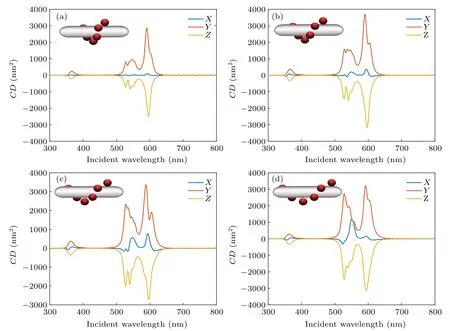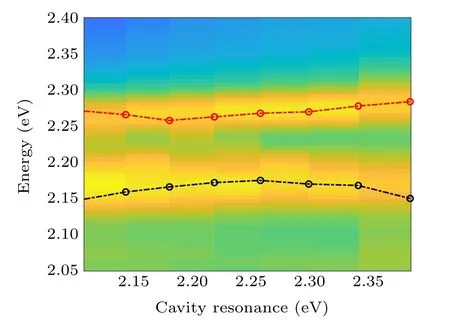Enhanced circular dichroism of plasmonic system in the strong coupling regime∗
2021-05-06YunFeiZou邹云飞andLiYu于丽
Yun-Fei Zou(邹云飞) and Li Yu(于丽),†
1School of Science,Beijing University of Posts and Telecommunications,Beijing 100876,China
2State Key Laboratory of Information Photonics and Optical Communications,Beijing University of Posts and Telecommunications,Beijing 100876,China
Keywords: plasmonic,chirality,strong coupling,circular dichroism
1. Introduction
The strong light matter interactions between light and quantum emitters in the optical cavity depend on the local density of electromagnetic fields,[1]opening multiple research fields with extensive applications in quantum networks,[2]single-atom lasers,[3]ultrafast single-photon switches,[4]and quantum information processing.[5–7]When quantum emitters are placed in an optical cavity, exciton electronic transitions would couple with cavity resonant modes, and when the rate of energy exchange between the two modes exceeds the damping of either,strong coupling regime is achieved,leading to the cavity and emitter mode hybridization and Rabi splitting.[8,9]During recent years, a series of noble metallic structures are widely used to investigate the strong coupling phenomenon with emitters in both theory and experiment.[10–16]Among these works, the plasmonic cavity based on localized surface plasmons (LSPs) is widely discussed due to the strong enhancement of electromagnetic fields.
Chiral molecules exhibit handedness in their geometry such that their mirror images cannot be aligned exactly with the original ones using rotational and translational transformations.[17]Chiral molecules with different handedness, left-and right-handed, can be distinguished by their interactions with circularly polarized light (CPL). The circular dichroism (CD) is often used to describe the chiroptical response, which implies the different absorption levels for left circularly polarized light(LCP)and right circularly polarized light (RCP).[18]However, CD is generally very small, typically of the order 10−3. Recent progress in LSPs paves the way for the enhancement of chiroptical response. The metallic nanostructures based on LSPs can enhance and tailor the optical chirality.[19–22]The ability of the electromagnetic field confinement provides a factor to amplify the optical chirality. Fano line shape is observed in the CD spectra in the hybridized structure made up of a chiral molecule and a metallic nanoparticle.[23]If we use more quantum emitters interacting with a metallic nanoparticle,there will be something interesting observed.
In this paper, we investigate the strong light matter interactions between a silver nanorod and an artificial chiral molecule. We note that the CD signal of a single artificial chiral molecule red is highly dependent on the chiral assembly,and the CD signal mainly contributes to dipolar Coulomb interactions between the internal particles.Considering the combined system of the silver nanorod and the chiral molecule,we find that the silver nanorod involved in this study is nonchiral and can be used as a plasmonic cavity to enhance exciton electronic transitions of the chiral molecule. The resonant plasmon–exciton coupling brings an obvious Rabi splitting in the CD spectra of the coupling system,indicating that the system reaches to the strong coupling regime. We also address the effect of coupling strength on the CD signal of the coupling system. Our discussion provides a method to amplify the optical chirality of the plasmonic chiral system.
2. Theoretical method
Figure 1(a) depicts the sketch of our model. A silver nanorod with the radius(rm)20 nm and the length(l)120 nm is considered as a plasmonic cavity. The permittivity of Ag is taken from Johnson and Christy.[24]The absorption of the bare nanorod under illumination from three directions is shown in Fig.1(b). The green line (X-incidence) indicates the transverse resonance,the red line(Y-incidence)and black dash line(Z-incidence) show the longitudinal resonance. The artificial chiral molecule is made up of six quantum dots with the radius (rd) 10 nm, which are in the helical arrangement with the helix constant h,and the helix constant h is adopted as nl,(n=0.1,0.2,0.3,...). The complex dielectric function of the quantum dot is approximated by a Lorentz model with a highfrequency dielectric constant:[25]


Fig.1. (a)The sketch of our model. (b)The absorption of the bare nanorod.The green line,red line,and black dash line indicate the X-directional incidence,Y-directional incidence,and Z-directional incidence,respectively.
3. Results and discussion
3.1. CD of the artificial chiral molecule


Table 1. Geometry asymmetry factor f.
3.2. Enhanced CD in the strong coupling regime


Fig.2. CD spectra of the artificial chiral molecule by changing helix constant h, the inset shows the geometry: (a) 0.2l, (b) 0.4l, (c) 0.6l,(d)0.8l.

Fig.3. CD signal of the nanorod-artificial chiral molecule system by changing helix constant h,the inset shows the geometry: (a)0.2l,(b)0.4l,(c)0.6l,(d)0.8l.

Fig.4. Plasmon enhanced localized electric field of the hybridized system,and the helix constant is 0.8l. The direction of the incident light is X,Y,Z in(a)–(c),respectively.
Besides, the LSPs resonance of the nanorod can further enhance the induced electric field,which can improve the absorption of the chiral molecule through electromagnetic interactions. The CDmolecule-nanorodoriginates from the molecular transition,which can be increased by the nanorod plasmon resonance and the chiral surface current in the plasmonic nanorod because of the chiral molecule. By comparing Figs. 2 and 3,we can see that the CD signal is enlarged due to the interactions between the chiral molecule and the plasmonic nanorod.
There are two amplification areas in Fig.3,one is the resonant wavelength regime(580 nm)induced by the longitudinal resonance of the silver nanorod,while the other(370 nm)is induced by the intrinsic of the material. The nanorod provides the largest electric fields at the resonant wavelengths and helps to amplify the CD signal which is presented by the matrix ˆP.In Fig.4,we simulate the electric field distribution of the coupling system when the helix constant is 0.8l,where the direction of the incident light is X,Y,and Z in Figs.4(a),4(b),and 4(c), respectively. Combined with Figs.3(d)and 4,we know that a large enhancement brings a big CD signal, namely, the plasmon resonance can improve the exciton electronic transition. Besides,we also calculate the geometry asymmetry factor f, as shown in Table 2. As we can see from Tables 1 and 2, the appearance of the nanorod also enlarges the geometry asymmetry factor, which indicates a large CD signal. Hence,the hybridized structure shows a strong chiral characteristic.

Table 2. Geometry asymmetry factor f.
In addition to the above mentioned,as shown in Fig.3,we can also observe two splitting peaks located around the resonant wavelength of the chiral molecule, indicating that coupling between the excitons of the molecule and the plasmonic cavity produces new hybrid modes. In order to provide physical insight into the coupling phenomenon,we use the coupled oscillator model to describe the coupling process.[15,25]In this model,the plasmonic cavity resonance and the molecular excitons are each described as a damped harmonic oscillator

where EPland EJare energies of the plasmon and excitons,g is the coupling strength, and γJand γPlare the corresponding damping rates. E is the eigenvalue corresponding to the energies of the new hybrid modes,and α and β are the eigenvector components(Hopfield coefficients)and satisfy|α|2+|β|2=1.The eigenvalues E are obtained from the equation:

The detuning δ =EPl−EJ. At zero-detuning case, the Rabi splitting ΩR=E+−E can be obtained from Eq.(3)as

where γPland γJare the corresponding plasmonic dissipation rate and exciton’s dissipation rate, respectively. Moreover, ifΩR= 2g > |γPl/2+γJ/2|, the coupling system reaches the strong coupling regime.[27]In Table 3, we estimate the values of coupling strength of Fig.3, and judge whether the hybridized system reaches strong coupling or not. Here, the γPlis 0.3 eV for X-directional incidence and 0.247 eV for Y-and Z-directional incidence, γJis 0.057 eV for all helix constant chiral molecules. The average of γPland γJis 0.178 eV for X-directional incidence and 0.152 eV for Y-and Z-directional incidence. From Table 3,we know that except h=0.2l of Xdirectional incidence,the rest are all reaching the strong coupling regime.

Table 3. Coupling strength(in eV).
As demonstrated in the previous discussion, when the coupling system reaches in the strong coupling regime,a clear Rabi splitting can be observed in the CD spectrum. To further investigate the strong coupling progress of this chiral system,we specifically focus on the impact of Ag nanorod resonance on the coupling. We increase the volume of Ag nanorod with a helix constant 0.8l and define the ratio of length to diameter as d=l/2π. The results present in Fig.5 indicate that,when we increase the volume (d), the two peaks of the two hybrid modes in the normalized CD signal are never combined, and this anti-crossing phenomenon is a signature of a strong coupling regime.

Fig.5. Two hybrid modes appear by changing d from 3.6 to 4.3. The red dots and black dots represent the energy of the two hybrid modes.
Furthermore,when the coupled system reaches the strong coupling regime,the rate of energy exchange between the plasmon resonance and chiral molecule is larger than the respective dissipation rates. Either the plasmon resonance or the chiral molecule may spontaneously emit a photon into the surrounding, which is then reabsorbed by the other. This results in an incoherent exchange of photon energy between them,and as the energy exchanges become faster,bringing a stronger coupling strength,the absorption can also be influenced,leading to a bigger CD signal.
4. Conclusion
In summary, we have studied the chiral optical response of an isolated chiral molecule and a coupling system of a hybridized plasmonic–chiral molecule, respectively. Our chiral molecule is composed of six quantum dots in helix arrangement, and the helix constant is tunable. The chirality of the chiral molecule is mainly contributed by the helix assembly,which can affect the dipolar-Coulomb interactions between the internal particles and bring about CD signals. As a hybridized system,the electromagnetic interactions enlarge the chiral response, affecting energy transfer between the plasmon resonance and molecule,coming into being a strong coupling phenomenon. The chiral strong coupling progress can amplify the CD signal of molecule through plasmon-enhancement,and a large coupling strength can lead to a strong CD signal.Our method provides a scenario for designing new plasmonic nanostructures with a strong chiral optical response.
杂志排行
Chinese Physics B的其它文章
- Speeding up generation of photon Fock state in a superconducting circuit via counterdiabatic driving∗
- Micro-scale photon source in a hybrid cQED system∗
- Quantum plasmon enhanced nonlinear wave mixing in graphene nanoflakes∗
- Restricted Boltzmann machine: Recent advances and mean-field theory*
- Nodal superconducting gap in LiFeP revealed by NMR:Contrast with LiFeAs*
- Origin of itinerant ferromagnetism in two-dimensional Fe3GeTe2∗
